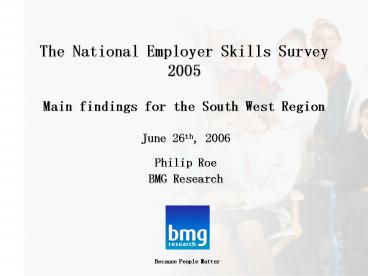June 26th, 2006 - PowerPoint PPT Presentation
1 / 27
Title:
June 26th, 2006
Description:
Workforce development by employers. Because People Matter. Demand for skills - vacancies. 17% of SW employers had a vacancy at time of survey. 2.9% of SW jobs were ... – PowerPoint PPT presentation
Number of Views:16
Avg rating:3.0/5.0
Title: June 26th, 2006
1
The National Employer Skills Survey2005Main
findings for the South West Region
June 26th, 2006 Philip Roe BMG Research
Because People Matter
2
Main survey themes
- Demand for skills vacancies
- Availability of skills recruitment difficulty,
skill shortages, and skill gaps - Recruitment of young people
- Workforce development by employers
3
Demand for skills - vacancies
- 17 of SW employers had a vacancy at time of
survey - 2.9 of SW jobs were vacant
4
Vacancy concentrations
SECTORS Retail, hospitality, financial services, construction, care
SIZE OF ESTABLISHMENT Small establishments (lt25 jobs) have 53 of vacancies but only a third of employment
LOCATION No great variation but marginally higher in West of England
5
Occupational bias
- Intermediate and lower, not managerial/professiona
l.
6
High intensity vacancies
- Skilled trades and operators in engineering,
general manufacturing, construction, food
processing, and garages - Sales staff in the retail sector
- Low grade staff in hospitality
- Care workers
- Technical staff in financial services and IT
sector - Teachers
- Nurses and technical staff in the health sector
7
Recruitment difficulty
- Under a third of all vacancies in the South West
(31) were hard-to-fill - 55 of these were hard-to-fill for skill
shortage reasons applicants lack required
skills, experience, and/or qualifications - Overall, 18 of vacancies were skill shortage
vacancies
8
Relation of recruitment difficulty to occupations
9
Top ten hard-to-fill and skill shortage
vacancies
Hard-to-fill Low skill hospitality staff Skilled construction trades Sales staff in retail Care assistants Chefs Admin/clerical in financial services Garage mechanics Skilled engineering trades Skilled retail trades (butchers, bakers, etc.) Skilled land-based workers Skill shortage Skilled construction trades Chefs Care assistants Garage mechanics Bus drivers Admin/clerical in financial services Skilled land-based workers Skilled retail trades Civil engineers HGV drivers
10
Trends in vacancies and recruitment difficulties,
2003-2005
South West England
Vacancies - 16 - 16
Hard-to-fill vacancies - 44 - 25
Skill shortage vacancies - 14 6
11
South West compared with England, 2005
South West England
Vacancies as of employment 2.9 2.7
Hard-to-fill vacancies as of vacancies 31 35
Skill shortage vacancies as of hard-to-fill vacancies 57 70
12
Broad labour market changes in South West,
2003-2005
13
Skills gaps
2003 2003 2005 2005
SW England SW England
of establishments with skills gaps 23 22 15 16
Skills gaps as of employment 10 11 5 6
14
Location of skill gaps
- 108,000 people in SW identified as not fully
proficient - A third of total in retail and hospitality
- Construction, engineering and care next highest
sectors - Fairly evenly distributed across different sizes
of establishment
15
Skills gaps in relation to occupations
16
Recruitment of young people
- Percent of employers recruiting.
South West England
16 year old school leaver 9 7
17-18 school/ College leaver 12 11
New graduate 9 9
17
Prepared for work?
- Percent of recruiting employers saying poor or
very poorly prepared for work. - 16 year olds 24
- 17-18 year olds 19
- New graduates 10
18
Why?
16 year olds 17-18 year olds New graduates
Lack motivation/ work ethic Lack of life/work experience Poor education/ general knowledge Lack motivation/ work ethic Lack of job-specific skills Lack of life/work experience Lack motivation/ work ethic Lack of business/ practical experience Lack of job-specific skills
19
Training by employers
- Percent of employers supplying training.
- Percent of employees trained is the same for SW
and England 35 off-the-job, 50 on-the-job
(not additive)
2003 2005
South West 62 65
England 59 65
20
Pattern of training
21
Who gets trained and how?
22
Use of Further Education Colleges
- Fewer employers which supply training used FE
Colleges in 2005 than in 2003 (30 down from 33) - More users satisfied with provision
- But.
- More significant dissatisfaction with
construction and vehicle maintenance courses - Twice as many employers use private providers
- Levels of satisfaction with private providers
higher than for FE
23
Overview lessening of pressure on skills
- Slowing of growth, in-migration, and skills
development combining to reduce pressure on
skills - An opportunity to concentrate on improvements in
supply in key area. - Which is technical/practical skills in
construction, manufacturing, catering, retail
24
Overview within-region disparities
- Evidence of weaker labour markets in South and
West of the region. - More vacancies
- Less training
- More recruits seen as de-motivated
- Supports the need for regional policy focus in
least prosperous sub-regions
25
Overview support to SMEs
- Small employers (with fewer than 25 staff)
- Have disproportionate numbers of vacancies,
hard-to-fill vacancies, and skill shortage
vacancies - More frequently see young recruits as
ill-prepared for work - More likely to say that skills problems cause
loss of business - Less likely to train staff
- Supports the need for policy focus on small hard
to reach businesses
26
Overview Further Education
- Some negative messages on FE.
- Falling proportion of training employers using FE
- Significant dissatisfaction in some sectors
- 1 in 5 employers recruiting a 17-18 year old are
dissatisfied with them - Half of training employers say FE courses are not
relevant - Supports policy to make FE provision more clearly
demand-led
27
For further information, please contact Philip
Roe, Account Director Tel No 0121-333-6006 E-mai
l philip.roe_at_bmgresearch.co.uk
Because People Matter































